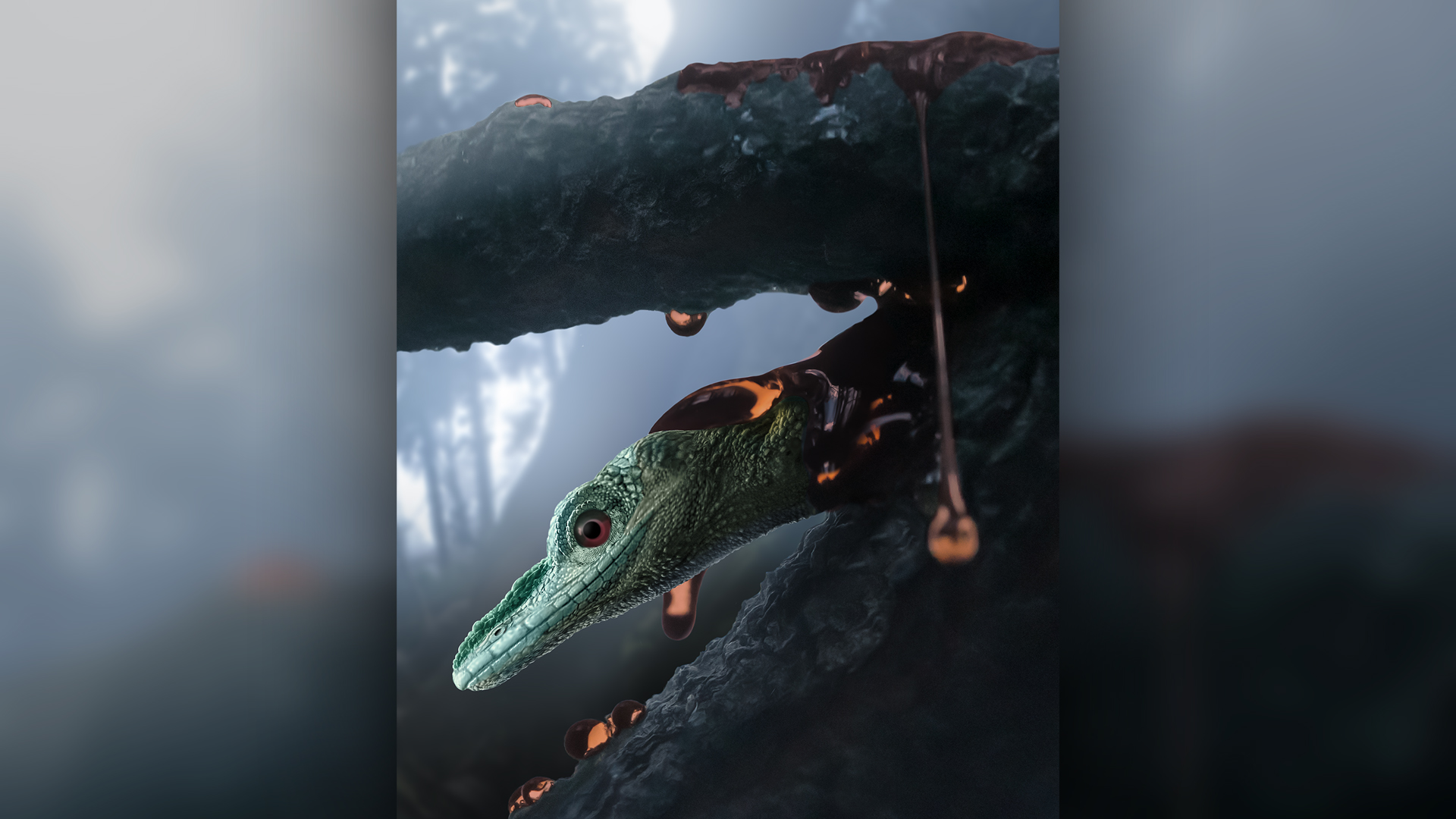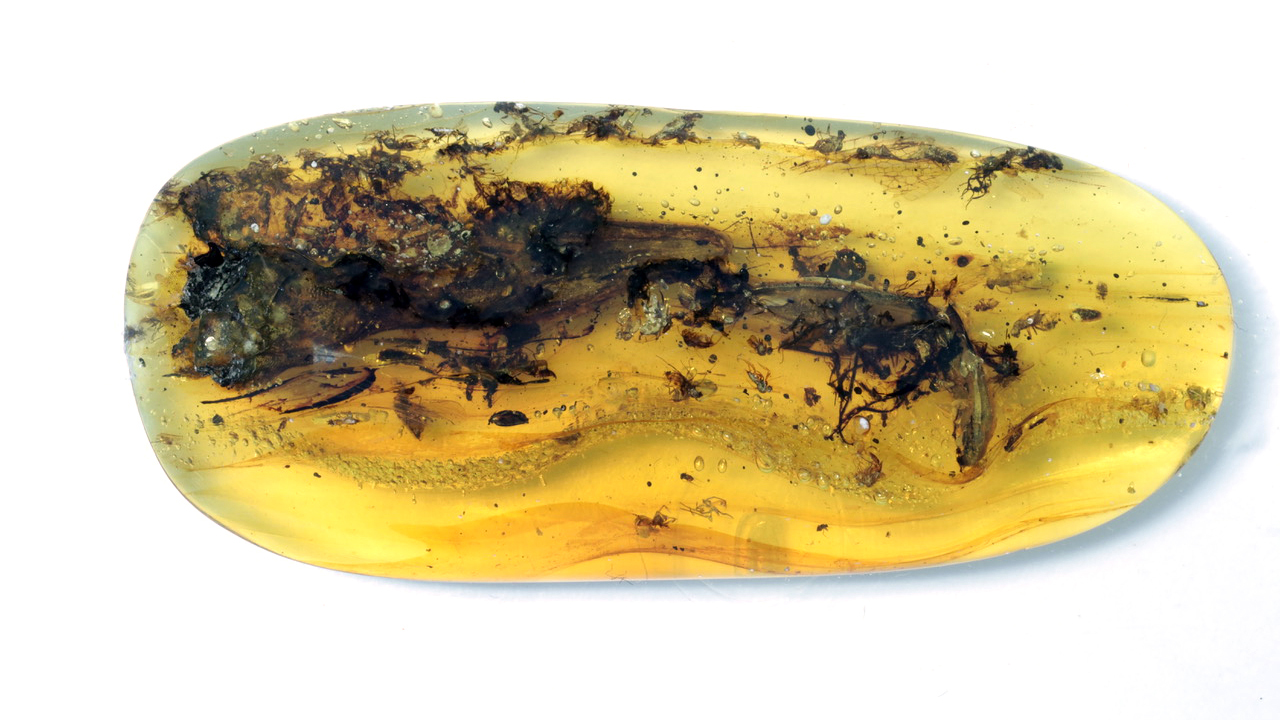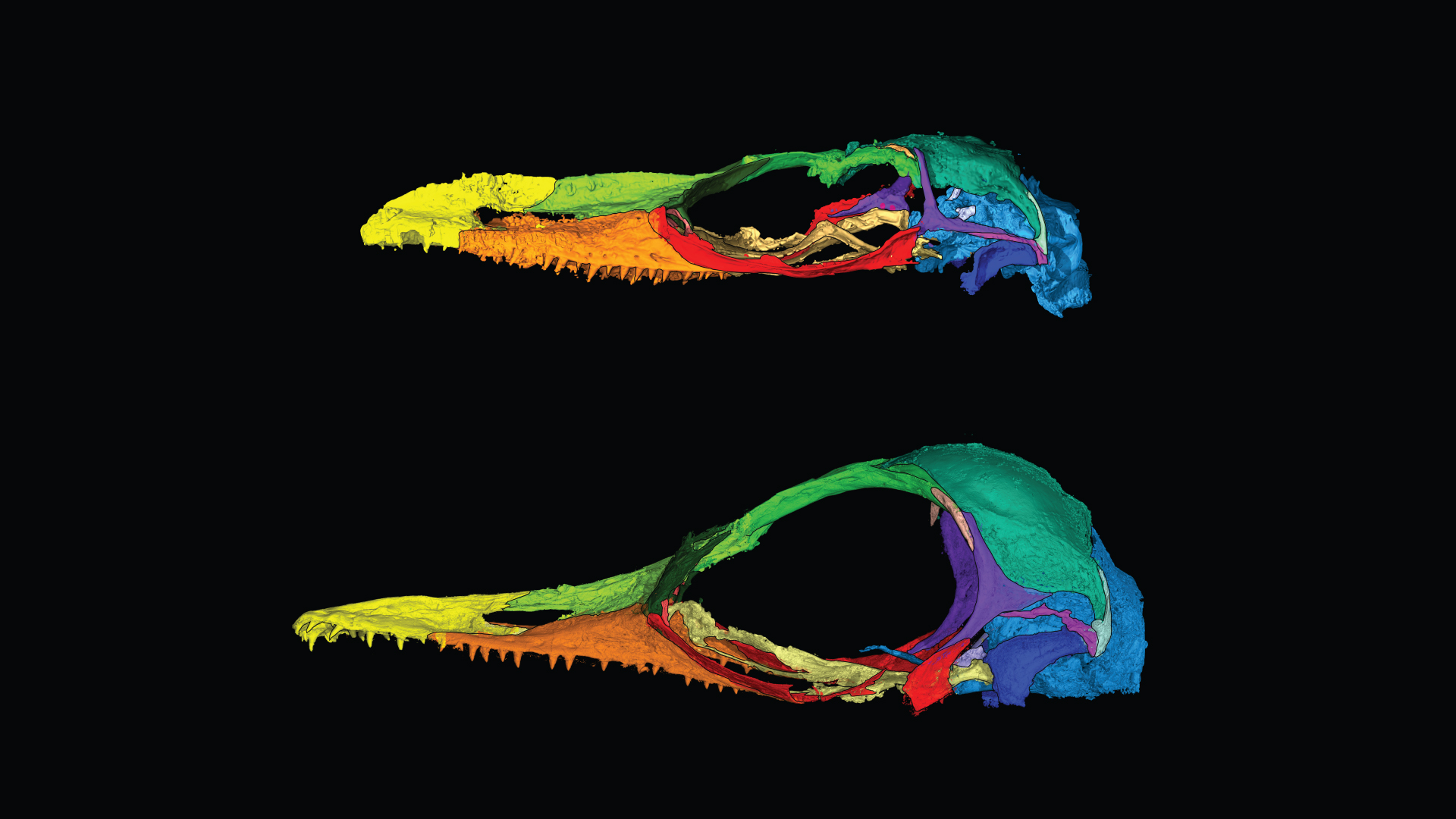'Strange beast' in amber is a very weird lizard
Oculudentavis lived about 99 million years ago in what is now Myanmar.

A fossil locked in a piece of amber dating to about 99 million years ago belongs to a newfound and highly bizarre species of extinct lizard. The fossil also helped scientists revise the lineage of another amber-locked discovery, also dating to that part of the Cretaceous period (145.5 million to 65.5 million years ago), that was originally thought to be the smallest known ancient bird.
When researchers described the hummingbird-size Oculudentavis khaungraae in March 2020, it was hailed as the tiniest dinosaur ever found (birds are a lineage of dinosaurs that survive to the present). But the specimen had a number of features that hinted it might be a lizard, and the journal retracted the study in July 2020, Live Science previously reported.
The new find, dubbed Oculudentavis naga, is a more complete specimen than O. khaungraae, having an intact skull and part of its spine and shoulders. After analyzing O. naga bone by bone, scientists determined that despite having some birdlike features it was a lizard — albeit a very strange lizard — and so was its "bird" cousin, according to a new study.
Related: In photos: Amber preserves Cretaceous lizards
Amber fossils form after an animal or plant becomes trapped in sticky resin from a coniferous tree. Over time, as the resin hardens into amber around the organic matter, it seals the organism away from oxygen and bacteria, and protects it from decay and environmental wear, according to the University of California Museum of Paleontology in Berkeley.
These fossils often retain soft tissue, such as the feathered wings torn from a bird, a feathered dinosaur's tail and an ancient lizard's tongue. Amber can also preserve rare instances of animal behavior — a 41 million-year-old insect sex romp, for instance.
Many amber fossils dating to the Cretaceous come from Kachin province in Myanmar — both Oculudentavis specimens came from the province's Aung Bar mine, according to the new study. Indigenous people there managed the amber deposits and mining prior to 2017, but after the Myanmar military seized control of the mines, their operations displaced thousands and are linked to human rights abuses, New Scientist reported in 2019.
Sign up for the Live Science daily newsletter now
Get the world’s most fascinating discoveries delivered straight to your inbox.
However, the O. naga amber specimen was acquired legally and exported from Myanmar prior to 2017 by study co-author Adolf Peretti, a gemologist with GRS Gemresearch Swisslab, the scientists reported.

Birdlike lizard or lizardlike bird?
O. naga's skull measures just 0.6 inches (14.2 millimeters) in length, and its long, tapering snout tipped with elongated nostrils is more like a bird's beak than a lizard's nose, according to the study published Monday (June 14) in the journal Current Biology.
When compared side-by-side with O. khaungraae (which measures 0.7 inches or 17.3 mm), the O. naga skull looks quite different: Its crown is flatter; it has a broader snout; and the eye opening, though large for a lizard, isn't quite as big as O. khaungraae's. Yet the animals are more closely related than those preserved skull shapes suggest, and that relationship — and their identification as lizards — became clearer when researchers X-ray scanned the skulls, created digital 3D models and examined them one bone at a time, said study co-author Edward Stanley, an associate scientist at the Florida Museum of Natural History in Gainesville, and director of the museum's Digital Discovery and Dissemination (3D) imaging lab.
Both specimens had teeth with long roots that were attached to the jaw. Known as pleurodont dentition, these teeth are common in lizards and "don't look like dinosaur teeth," which are seated in sockets, Stanley told Live Science.
"There's a bone at the back of the jaw called a quadrate that attaches the lower jaw to the top of the skull and the braincase — that's also very lizardlike in both specimens," Stanley said. "The roof of the mouth, while unusual for a lizard, is much more lizardlike than birdlike," Stanley added. A skull bone that's shaped like a hockey stick, called a jugal, ticked yet another box on the lizard list of features for both animals, the scientists wrote in the study.
Yet O. naga and O. khaungraae also both had "a strange-looking bone" directly in front of the eye socket that was unlike anything seen in most lizards, Stanley said.
"The fact that a lizard skull — the first specimen, the holotype of Oculudentavis khaungraae — could be misidentified as a bird is a good indication that this reptile is a really unusual one," said lead study author Arnau Bolet, a research fellow at the Autonomous University of Barcelona's Miquel Crusafont Catalan Institute of Paleontology.

Deformed by time
One explanation for why the specimens look so different from each other — and why O. khaungraae had a more birdlike appearance, with a rounder skull and pointier snout — could be that the skulls were deformed by fossilization. As O. naga was a more complete specimen, it provided the scientists with a clearer picture of the bones. After scanning the skulls with computed X-ray tomography (CT), the researchers digitally reversed deformation in the models, revealing that the two species were more similar than they first appeared.
"We used CT data to try to isolate all the individual bones piece by piece, so we really broke it down into its component parts," Stanley said. "When you do that, it becomes a lot clearer: Not only is this thing a lizard, but these things are very closely-related weird lizards."
O. naga was less laterally deformed than O. khaungraee, making it "less prone to interpretation as a bird," Bolet told Live Science in an email. Nevertheless, the fossil "still shows that Oculudentavis deviates from the standard lizard morphology in some aspects, rendering it a highly interesting animal," Bolet added. "They show that there is much to be learned about the evolution of species in the past, and give us a glimpse of the way different groups — in this case, lizards — diversified to occupy different roles in the ecosystem."
While Oculudentavis' status as a bizarre lizard genus is now clearer, its exact position on the lizard family tree is still unknown, the scientists reported. But with all the CT data now available for free at MorphoSource, an online repository for 3D scientific data, other researchers will have the opportunity to try to solve this intriguing evolutionary puzzle.
"You can 3D-print this model or use a computer simulation to test things like bite force, or jaw angle — that might tell a little more about what this animal was doing in life. You can isolate the inner ear of the specimen, that might tell you about the type of environment it lived in, whether it lived up in trees or on the ground," Stanley said. "We're keen to work on it, and we're keen for other people to work on it as well."
Originally published on Live Science.

Mindy Weisberger is an editor at Scholastic and a former Live Science channel editor and senior writer. She has reported on general science, covering climate change, paleontology, biology and space. Mindy studied film at Columbia University; prior to Live Science she produced, wrote and directed media for the American Museum of Natural History in New York City. Her videos about dinosaurs, astrophysics, biodiversity and evolution appear in museums and science centers worldwide, earning awards such as the CINE Golden Eagle and the Communicator Award of Excellence. Her writing has also appeared in Scientific American, The Washington Post and How It Works Magazine. Her book "Rise of the Zombie Bugs: The Surprising Science of Parasitic Mind Control" will be published in spring 2025 by Johns Hopkins University Press.









